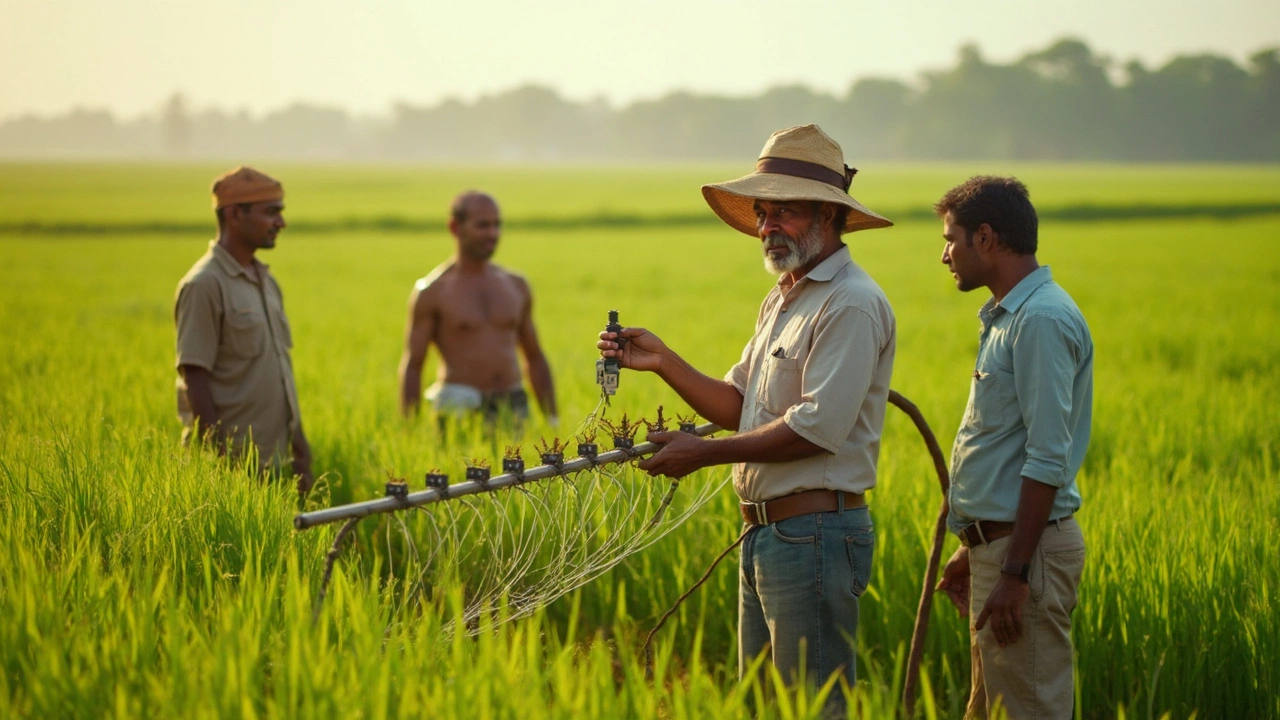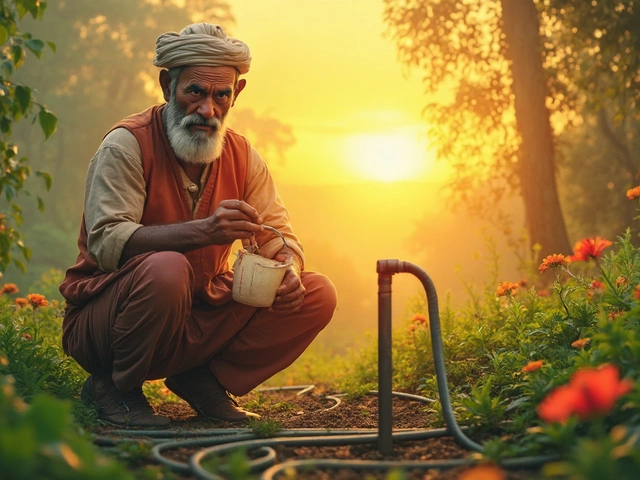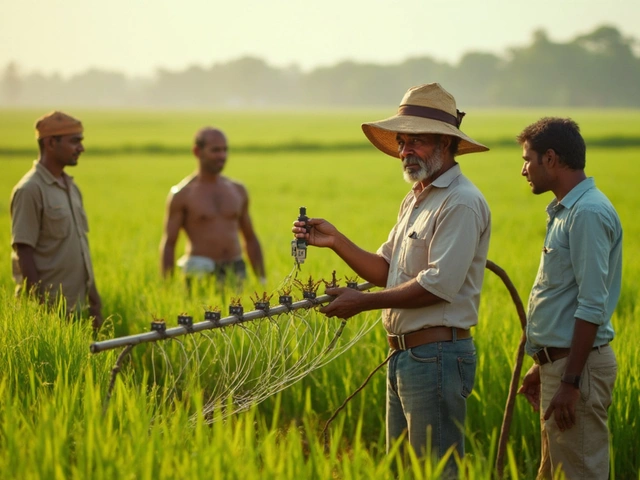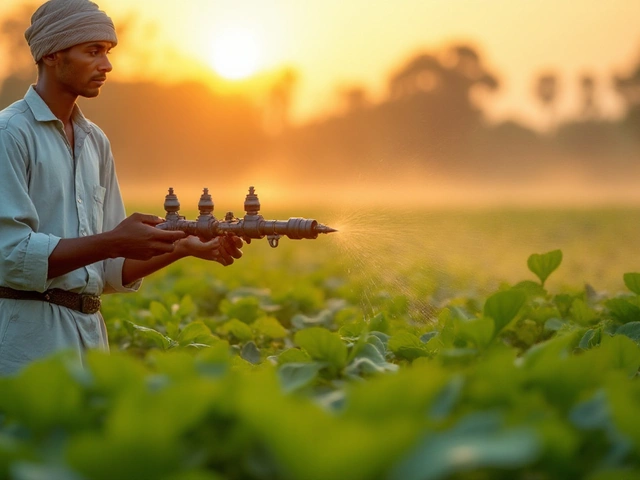Drip irrigation might seem like a no-brainer. You save water, cut costs, and help the environment. But have you ever wondered why so many farmers stick to methods like flood irrigation or sprinklers instead? Turns out, there's way more to the story. Let's dive into it.
First off, the initial investment for setting up a drip system can be a major hurdle. The thought of spending thousands upfront isn't something every farmer can stomach, especially if their budget's already tight.
Then, there's the issue of complexity. Setting up a drip irrigation system isn't as straightforward as just turning on a tap. It requires a basic understanding of irrigation design, and not every farmer has the time or resources to become an expert.
- Understanding Drip Irrigation
- Cost vs. Benefits
- Installation Challenges
- Maintenance Demands
- Adaptation and Resistance
- Future Potential
Understanding Drip Irrigation
Imagine watering your plants using a water bottle with tiny holes poked in the cap. That's basically what drip irrigation does, but on a much larger scale. Instead of flooding a field or spraying water into the air, drip irrigation delivers moisture straight to the plant roots, drop by drop. This method is a game-changer for water conservation, reducing water usage by up to 70% compared to traditional methods.
So, how does it work? The system consists of a network of tubes and emitters. Tubes run along the rows of crops, with small nozzles or emitters spaced out to let the water drip directly onto the soil. The whole thing is usually powered by gravity or a low-pressure pump. This targeted watering approach helps minimize evaporation and runoff.
Agricultural innovation in drip irrigation technology continues to evolve. Some systems now include sensors that monitor soil moisture levels and adjust water flow automatically. This means farmers can optimize water use without constantly adjusting the settings themselves.
But it's not just about saving water. Drip irrigation can improve yield because plants get consistent, precise amounts of water, reducing stress. This system can also help prevent weeds since only specific areas around the plants are watered.
Common Components of Drip Systems
- Drip lines: These are the main arteries of the system, carrying water to the crops.
- Emitters: These small devices release water slowly and are the main point of water delivery.
- Filters: Before water reaches the plants, it's filtered to prevent clogs in the emitters.
- Pressure regulators: These ensure the water pressure remains at an optimal level for efficient delivery.
Overall, the adoption of drip irrigation systems can be a smart move for farmers in arid regions or those looking to maximize water efficiency. However, understanding the system's components and proper installation is crucial to reaping its full benefits.
Cost vs. Benefits
One of the biggest questions many farmers ask is whether investing in drip irrigation is worth it. The short answer? It depends on several factors, like the type of crops you're growing and your specific water situation. But here's what you need to consider.
Initial Costs
Let's face it, the start-up cost for a drip irrigation system can be hefty. You might be looking at anywhere from $1,000 to $3,000 per acre, depending on the system's sophistication. Ouch, right? For small farmers or those on a tight budget, this can seem almost impossible.
Potential Savings
But here's where things get interesting. The potential savings could outweigh those initial expenses. Water conservation is no joke—traditional watering methods can lead to significant water waste, sometimes up to 50%. With drip irrigation, you can reduce water usage by 30% to 70%, depending on the crop and the climate. That's a big deal, especially in areas facing water scarcity.
Impact on Crop Yield
Oh, and let's not forget the impact on crop yield. Many farmers who switch to drip irrigation report healthier plants and increased yield—sometimes by up to 20%. When plants get water directly to the roots, they tend to be healthier, which usually means more produce to harvest and sell.
| Factor | Traditional Irrigation | Drip Irrigation |
|---|---|---|
| Water Usage | High | Low |
| Initial Cost | Low | High |
| Yield Increase | Standard | Up to 20% |
Ultimately, if you're planning to farm over the long haul, making that initial investment could pay off big time. But it's not just about dollars and cents; it's also about doing what's best for the environment. However, you'll need to weigh those costs and savings against your current financial situation and future farming goals.
Installation Challenges
Kicking off with drip irrigation installation can feel like a dive into the deep end of the pool. It's not as simple as rolling out some tubing and calling it a day. There's a bit of a science to it, and a lot of farmers find this intimidating.
First, you need to design your system properly. This means deciding how much water each plant should get and in what time frame. Miscalculating means thirsty rows or soggy patches, neither of which are ideal for crop health. Getting this plan right requires attention to detail and sometimes a decent grasp of math.
Tools and Equipment
You also need the right gear: pipes, emitters, filters, and connectors. Choosing the right stuff isn't always straightforward. Each component needs to work together harmoniously for the system to run smoothly.
And let's talk numbers for a second. On average, the cost of setting up a basic system for just an acre can run anywhere from $2,000 to $5,000. That's a hefty chunk of change for many folks.
Skilled Labor
Now, imagine trying to put the whole thing together. Most farmers aren't trained irrigation specialists. Without some guidance or hiring an expert, it's easy to make costly mistakes in the setup process that could affect performance.
- Placing emitters too close or too far from plants.
- Improper pipe fitting can lead to leaks or uneven pressure.
- Poor filtration might cause clogs, leading to inconsistent water distribution.
The good news is that workshops and training sessions are popping up more often, offering farmers a chance to learn the ropes. But until more support systems are in place, these installation challenges remain a barrier for many looking to embrace this promising technology.
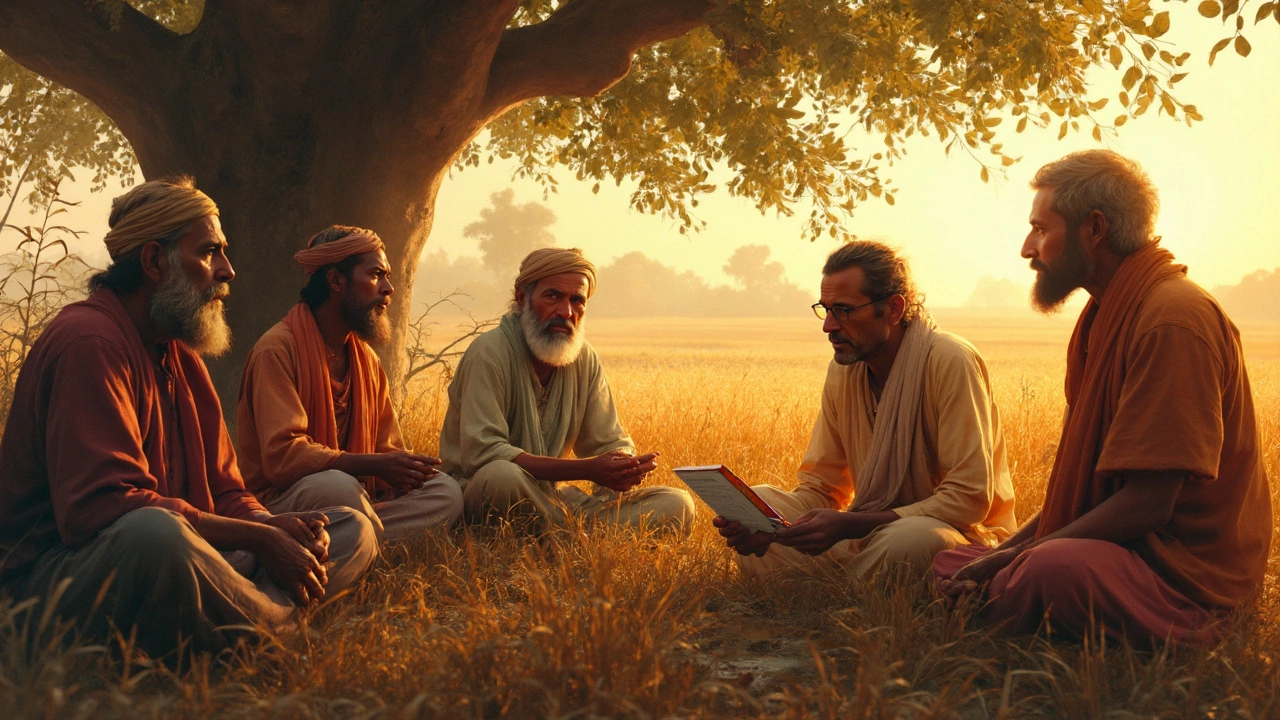
Maintenance Demands
So, you've invested in a drip irrigation system and think you're done? Not so fast. One of the biggest reasons farmers hesitate to use these systems is because of the ongoing maintenance. Trust me, it's more than just setting it and forgetting it.
Here's the scoop: clogging is a major issue. Even if you're using quality water sources, little bits of dirt, algae, or even calcium deposits can make a mess of those tiny drip emitters over time. When that happens, you might end up watering an area you didn't mean to or worse, not watering at all.
Dealing with Clogs
What do you do about clogs? Regular checks are essential. Many farmers think, "I'll get to it later," but regular inspections could save you a headache later on. Back flushing the system or using filters can help keep things running smoothly.
System Repairs
Parts of the system definitely won't last forever. Tubing can crack under the sun or get chewed on by curious critters. Replacement parts should always be on hand—having a stash of spare drippers and connectors is a good idea.
Know When to Call in the Pros
Sometimes, despite the best care, problems arise that need professional attention. If a problem persists, it might be worth it to call in an expert to avoid turning it into a bigger issue down the line.
If you stay on top of maintenance, a drip system can work great for you. The kicker? It takes time and diligence, but the potential water savings and crop benefits often outweigh the hassle.
Adaptation and Resistance
Why are some farmers hesitant to jump on the drip irrigation bandwagon, despite its benefits? A lot of it comes down to familiarity and trust in traditional techniques. When something's worked for generations, it can be tricky to switch gears.
One major factor is education. Many farmers grew up using flood or sprinkler systems, and there’s a learning curve to adopting new methods. That learning curve can feel like a steep hill, especially when time and patience aren't in overflow supply.
Fear of the Unknown
There’s also a fear of failure. What if the new system doesn't perform as advertised? Initial teething problems might lead to crop damage or water wastage, which many can't afford. It’s a valid concern, but often, this fear can be reduced with training and support.
Financial Insecurity
Let's not forget the financial side of things. The cost of setting up drip irrigation is one thing, but what if it doesn’t pay off in increased yields or water savings as hoped? For small-scale farmers, the financial gamble can seem too great.
| Year | Farmers Adopting Drip Irrigation (%) |
|---|---|
| 2020 | 25% |
| 2021 | 27% |
| 2022 | 29% |
Interestingly, data suggests a gradual increase in adoption. In 2020, about 25% of farmers had made the switch. By 2022, that number had crept up to about 29%. Progress is slow but steady, promising for future potential in widespread application.
Support Systems Needed
To speed up the process, more on-the-ground education programs could make a difference. Workshops and local success stories might just be the push some need to give drip a chance. In the end, farming is as much about community as it is about crops.
Future Potential
Even though many farmers haven’t hopped on the drip irrigation train yet, the future looks pretty promising for this water-saving method. As technology gets better and becomes more affordable, we might see a big shift toward this technique.
Water Conservation Benefits
One of the most significant advantages is its potential to conserve water. With climate change and water shortages looming, farmers need ways to use water more effectively. Drip irrigation uses up to 50% less water compared to traditional methods, making it a smart choice for sustainable farming.
Technological Advances
Technology is making strides in making drip systems more accessible. Newer systems are easier to install and need less maintenance. Plus, many new setups have smart tech features that adjust water flow based on soil moisture levels, which can optimize water usage better than ever.
Agricultural Output
The impact on crop yields is another biggie. Drip irrigation can increase overall yield by delivering water directly to plant roots, resulting in healthier crops. There’s less disease because the leaves stay dry, reducing the risk of mold and other plant diseases.
Impact on Costs
Costs are always on farmers' minds. As more companies produce these systems and scale tech innovations, we can expect the costs to drop, making it more accessible for even small-scale farmers. An investment today could lead to streamlined expenses in the future, particularly when water costs rise or water becomes less available.
Environmental Responsibility
Farming can have a heavy footprint, but drip irrigation is a step toward more eco-friendly practices. By using less water and promoting healthier crops, this system can help reduce environmental impacts and runoffs that may affect nearby waterways.
While drip irrigation hasn't reached every farmer’s field yet, the future holds a lot of promise. It’s environmentally friendly, potentially cheaper in the long run, and supports better yields. For those who dare to innovate, drip irrigation could just be the answer to modern agricultural challenges.
